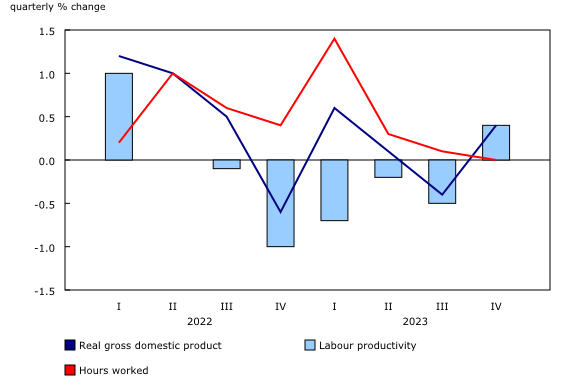Labour productivity, hourly compensation and unit labour cost, fourth quarter 2023
Released: 2024-03-06
Fourth quarter 2023
0.4% 
(quarterly change)
Productivity rises for the first time in seven quarters
Labour productivity of Canadian businesses rose 0.4% in the fourth quarter, after falling 0.5% in the third quarter. This was the first gain since the first quarter of 2022 (+1.0%).
Without increasing the hours worked, businesses were able to increase their output in the fourth quarter, resulting in productivity growth.
Real gross domestic product (GDP) of businesses rebounded 0.4% in the fourth quarter, after decreasing 0.4% the previous quarter.
Hours worked are flat, after little change in the previous quarter
Meanwhile, hours worked in the business sector were stable in the fourth quarter, after edging up (+0.1%) in the previous quarter.
The number of jobs (-0.1%) and average hours worked (+0.1%) in the fourth quarter also posted little change for a second consecutive quarter.
In the fourth quarter, there were slight changes in hours worked in both goods-producing businesses (+0.1%) and service-producing businesses (-0.1%). Overall, 7 of the 16 industry sectors posted increases, while real estate services and professional services were virtually unchanged.
Productivity increases in both goods- and service-producing businesses
Service-producing businesses saw their productivity rise by 0.4% in the fourth quarter. This was the first increase in six quarters, and retail trade contributed the most to the increase. For goods-producing businesses, productivity (+0.1%) edged up after four quarters of decline.
In total, productivity was up in 7 of the 16 main industry sectors, and it was unchanged in 4: manufacturing, finance and insurance, professional services, and administrative services.
Unit labour costs decline for the first time in 13 quarters.
Since growth in hourly compensation was slower than productivity growth, the unit labour costs edged down 0.1% in the fourth quarter, after increasing for 12 consecutive quarters. Unit labour costs represent the costs of wages and benefits a business pays its workers to produce one unit of output.
Annual averages for 2023
On average, over 2023, labour productivity of Canadian businesses fell 1.8%, a third consecutive annual decline.
This decline for the year in productivity reflects the 0.6% increase in real GDP of businesses, combined with a 2.5% increase in hours worked. Growth in business output and hours worked slowed for a second consecutive year.
Most of the decline in productivity observed in 2023 was attributable to goods-producing businesses (-3.4%), which fell for a third consecutive year. Productivity in service-producing businesses decreased 0.8%, following zero growth in the previous year.
Did you know we have a mobile app?
Get timely access to data right at your fingertips by downloading the StatsCAN app, available for free on the App Store and on Google Play.
Sustainable Development Goals
On January 1, 2016, the world officially began implementing the 2030 Agenda for Sustainable Development—the United Nations' transformative plan of action that addresses urgent global challenges over the following 15 years. The plan is based on 17 specific Sustainable Development Goals (SDGs).
The release "Labour productivity, hourly compensation and unit labour cost" is an example of how Statistics Canada supports the reporting on the global SDGs. This release will be used to help measure the following goal:

Note to readers
Revisions
With this release, data were revised back to the first quarter of 1997 at the aggregate and industry levels. These revisions are consistent with those incorporated in the annual benchmarks on provincial and territorial labour productivity and related measures, released on February 9, 2024. They are also consistent with those incorporated in the quarterly gross domestic product (GDP) by income and expenditure and monthly GDP by industry, released on February 29, 2024.
In addition, all series (except for GDP and the implicit price deflator) at the aggregate level were subject to revision going back to 1981, as a result of revisions to the values for the 2017 reference year. However, the resulting revisions to growth rates were negligible.
Productivity measures
The term productivity in this release refers to labour productivity. For the purposes of this analysis, labour productivity and related variables cover the business sector only.
Labour productivity is a measure of real GDP per hour worked.
Unit labour cost is defined as the cost of workers' wages and benefits per unit of real GDP.
The approach to measuring real output in the business sector differs from the one that is used in the estimates by industry. For the business sector, output is measured using the expenditure-based GDP approach at market prices. This approach is similar to that used for the quarterly measures of productivity in the United States. However, output by industry is based on the value added at basic prices.
All the growth rates reported in this release are rounded to one decimal place. They are calculated with index numbers rounded to three decimal places, which are now available in data tables.
All necessary basic variables for productivity analyses (such as hours worked, employment, output and compensation) are seasonally adjusted. For information on seasonal adjustment, see Seasonally adjusted data – Frequently asked questions.
Next release
Labour productivity, hourly compensation and unit labour cost data for the first quarter of 2024 will be released on June 5.
Products
The Economic accounts statistics portal, accessible from the Subjects module of the Statistics Canada website, features an up-to-date portrait of national and provincial economies and their structures.
The Latest Developments in the Canadian Economic Accounts (13-605-X) is available.
The User Guide: Canadian System of Macroeconomic Accounts (13-606-G) is available.
The Methodological Guide: Canadian System of Macroeconomic Accounts (13-607-X) is available.
The study, "Canadian regional labour statistics and inter-regional movements of paid workers, 2001 to 2021," which is part of Latest Developments in the Canadian Economic Accounts (13-605-X), is available.
Contact information
For more information, or to enquire about the concepts, methods or data quality of this release, contact us (toll-free 1-800-263-1136; 514-283-8300; infostats@statcan.gc.ca) or Media Relations (statcan.mediahotline-ligneinfomedias.statcan@statcan.gc.ca).
- Date modified:

